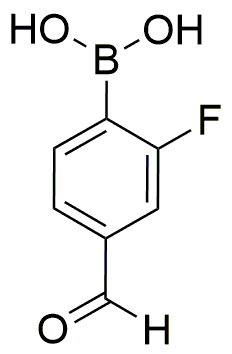2-Fluoro-4-formylphenylboronic acid is widely utilized in research focused on:
- Drug Development: This compound serves as a key intermediate in the synthesis of various pharmaceuticals, particularly in the development of anti-cancer agents. Its unique structure allows for the modification of drug properties, enhancing efficacy.
- Organic Synthesis: It plays a significant role in cross-coupling reactions, which are essential for creating complex organic molecules. This application is particularly valuable in the fields of materials science and organic electronics.
- Bioconjugation: The boronic acid functionality enables selective binding to diols, making it useful in bioconjugation techniques. This is crucial for creating targeted drug delivery systems and diagnostic tools.
- Fluorescent Probes: The compound can be utilized in the development of fluorescent probes for biological imaging. Its ability to form stable complexes enhances the sensitivity and specificity of imaging techniques.
- Environmental Chemistry: It is applied in the detection and removal of pollutants, particularly in water treatment processes. The compound’s reactivity allows for the capture of harmful substances, contributing to environmental protection efforts.
Informations générales
Propriétés
Sécurité et réglementation
Applications
2-Fluoro-4-formylphenylboronic acid is widely utilized in research focused on:
- Drug Development: This compound serves as a key intermediate in the synthesis of various pharmaceuticals, particularly in the development of anti-cancer agents. Its unique structure allows for the modification of drug properties, enhancing efficacy.
- Organic Synthesis: It plays a significant role in cross-coupling reactions, which are essential for creating complex organic molecules. This application is particularly valuable in the fields of materials science and organic electronics.
- Bioconjugation: The boronic acid functionality enables selective binding to diols, making it useful in bioconjugation techniques. This is crucial for creating targeted drug delivery systems and diagnostic tools.
- Fluorescent Probes: The compound can be utilized in the development of fluorescent probes for biological imaging. Its ability to form stable complexes enhances the sensitivity and specificity of imaging techniques.
- Environmental Chemistry: It is applied in the detection and removal of pollutants, particularly in water treatment processes. The compound’s reactivity allows for the capture of harmful substances, contributing to environmental protection efforts.
Documents
Fiches de données de sécurité (FDS)
La FDS fournit des informations de sécurité complètes sur la manipulation, le stockage et l’élimination du produit.
Spécifications du produit (PS)
Le PS fournit une description complète des propriétés du produit, notamment sa composition chimique, son état physique, sa pureté et les exigences de stockage. Il détaille également les plages de qualité acceptables et les applications prévues du produit.
Certificats d'analyse (COA)
Recherchez des certificats d'analyse (COA) en saisissant le numéro de lot du produit. Les numéros de lot et de lot se trouvent sur l'étiquette d'un produit, après les mots « Lot » ou « Lot de fabrication ».
Numéro de catalogue
Numéro de lot/série
Certificats d'origine (COO)
Ce certificat d'exploitation confirme le pays dans lequel le produit a été fabriqué, et détaille également les matériaux et composants utilisés et s'il est issu de sources naturelles, synthétiques ou autres sources spécifiques. Ce certificat peut être requis pour les douanes, le commerce et la conformité réglementaire.
Numéro de catalogue
Numéro de lot/série
Fiches de données de sécurité (FDS)
La FDS fournit des informations de sécurité complètes sur la manipulation, le stockage et l’élimination du produit.
DownloadSpécifications du produit (PS)
Le PS fournit une description complète des propriétés du produit, notamment sa composition chimique, son état physique, sa pureté et les exigences de stockage. Il détaille également les plages de qualité acceptables et les applications prévues du produit.
DownloadCertificats d'analyse (COA)
Recherchez des certificats d'analyse (COA) en saisissant le numéro de lot du produit. Les numéros de lot et de lot se trouvent sur l'étiquette d'un produit, après les mots « Lot » ou « Lot de fabrication ».
Numéro de catalogue
Numéro de lot/série
Certificats d'origine (COO)
Ce certificat d'exploitation confirme le pays dans lequel le produit a été fabriqué, et détaille également les matériaux et composants utilisés et s'il est issu de sources naturelles, synthétiques ou autres sources spécifiques. Ce certificat peut être requis pour les douanes, le commerce et la conformité réglementaire.


